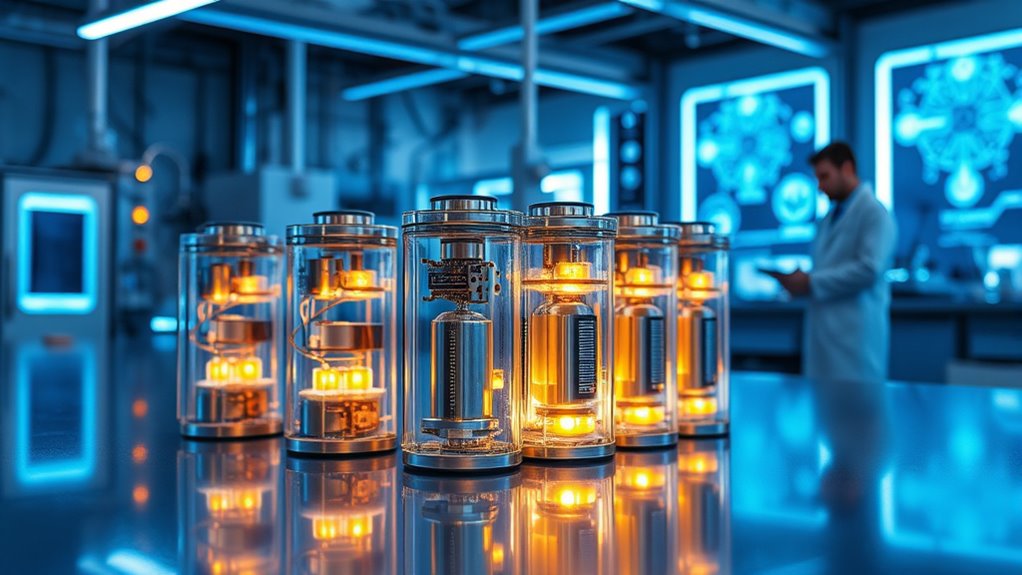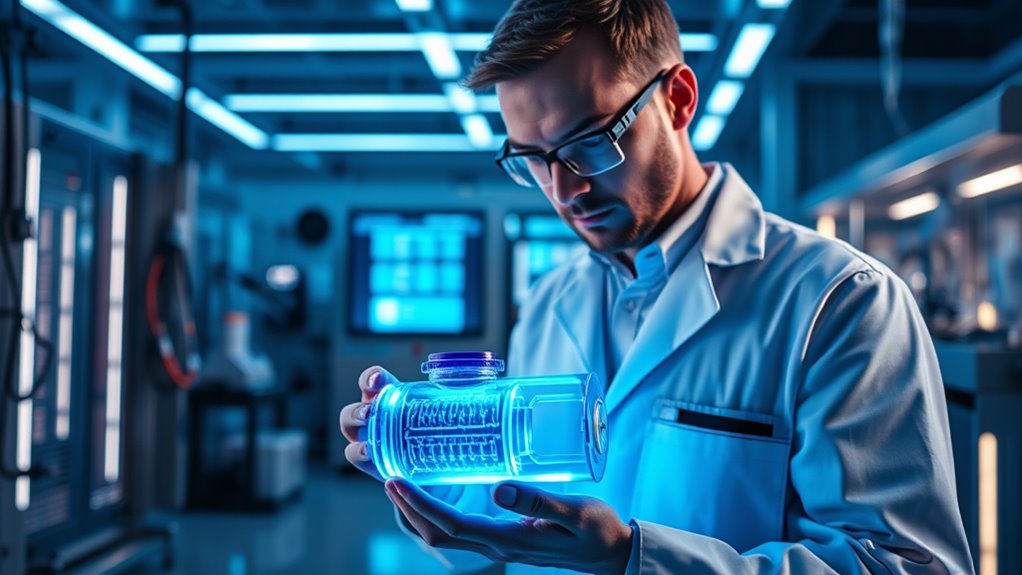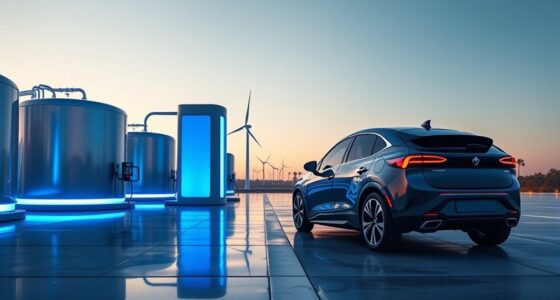By 2025, you’ll see advanced batteries like solid state technology combined with silicon anodes revolutionize energy storage. These batteries are safer, more powerful, and last longer than traditional lithium-ion ones. They enable faster charging and are ideal for electric vehicles, drones, and portable devices. This innovation promises a future with smaller, lighter, and more reliable power sources. Stay tuned to learn how these breakthroughs could change the way you use energy every day.
Key Takeaways
- Solid state batteries are emerging as safer, higher energy density alternatives to traditional lithium-ion batteries by 2025.
- Integration of silicon anodes can increase battery capacity by tenfold, enhancing performance and charging speed.
- Development of composite materials and nanostructures addresses silicon’s expansion issues, improving durability.
- The transition to solid state and silicon-based batteries will enable more compact, lightweight, and high-performance devices.
- Widespread adoption of these advanced batteries will revolutionize electric vehicles, drones, and portable electronics by 2025.

Have you ever wondered what powers the next generation of electric vehicles and portable devices? As technology advances, traditional lithium-ion batteries are reaching their limits, prompting researchers to explore innovative solutions. One promising development is solid state batteries, which replace the liquid electrolyte with a solid material. This shift offers numerous advantages, including enhanced safety, higher energy density, and longer lifespan. Unlike conventional batteries, solid state variants reduce the risk of leaks, fires, and degradation over time, making them ideal for high-performance applications. Manufacturers are also experimenting with silicon anodes, which have the potential to dramatically increase battery capacity. Silicon can hold about ten times more charge than the graphite used in current lithium-ion anodes, meaning longer-lasting, more powerful batteries.
Solid state batteries and silicon anodes are revolutionizing energy storage for safer, more powerful, and longer-lasting devices.
In the push toward more efficient energy storage, solid state technology is gaining profound traction. You’ll find that these batteries can operate at higher voltages and deliver more energy in a smaller, lighter package. This makes them especially attractive for electric vehicles, where weight and space are critical factors. The solid electrolyte not only improves safety but also allows for faster charging times, reducing downtime and making electric driving more convenient. As researchers perfect the manufacturing processes, expect to see solid state batteries becoming commercially viable by 2025, transforming the landscape of portable and automotive power sources.
Meanwhile, silicon anodes are changing the way batteries store energy. Traditional graphite anodes are limited in their capacity, but silicon, with its vast charge-holding potential, can considerably boost overall battery performance. One challenge, however, is that silicon tends to expand and contract during charge cycles, which can lead to mechanical failure. Engineers are actively developing composite materials and nanostructures that can accommodate silicon’s expansion, ensuring longevity and stability. When integrated into solid state batteries, silicon anodes can harness their high capacity while maintaining safety and durability. This combination promises to deliver batteries that not only last longer but also charge faster and provide more power—key factors for the future of electric vehicles, drones, and portable electronics.
As these technologies mature, expect to see a shift from today’s lithium-ion standards toward more advanced, safer, and more efficient energy storage solutions. The fusion of solid state designs with silicon anodes signifies a pivotal step toward batteries that meet the demands of tomorrow’s high-performance devices. By 2025, these innovations will likely be mainstream, powering everything from electric cars to portable gadgets, and redefining what’s possible in energy storage.
Frequently Asked Questions
What Are the Environmental Impacts of Emerging Battery Materials?
When you consider emerging battery materials, the environmental footprint and resource depletion become key concerns. These new materials often require less invasive mining, reducing habitat destruction. However, some may still involve resource depletion or generate hazardous waste during production. You should stay informed about how these innovations aim to balance performance with sustainability, ensuring their environmental impacts are minimized, so future batteries are both powerful and eco-friendly.
How Will New Battery Tech Affect Vehicle Manufacturing Costs?
Imagine upgrading your vehicle’s engine with advanced, efficient parts. New battery tech promises to do just that, reducing manufacturing costs by streamlining supply chains and using cheaper, more abundant materials. This shift can lower overall vehicle prices and make electric vehicles more accessible. As a result, you’ll benefit from cost reductions, faster production, and a more sustainable supply chain that powers the future of transportation.
Are There Safety Concerns With Solid-State Batteries?
You might wonder if solid-state batteries pose safety concerns. Generally, solid state safety is higher because these batteries use a stable, non-flammable solid electrolyte, reducing risks like fires or leaks. Their enhanced battery stability makes them safer than traditional lithium-ion cells. However, researchers continue refining materials to prevent issues like dendrite growth, ensuring solid-state batteries remain a reliable, safer energy source for future applications.
How Scalable Are These New Battery Manufacturing Processes?
Imagine building a vast, intricate city from scratch; that’s what scaling new battery manufacturing processes feels like. You’ll face scalability challenges and manufacturing hurdles, like ensuring consistent quality and managing complex supply chains. While promising, these processes aren’t yet a smooth, rapid expansion. To power the future, you need to navigate these challenges carefully, turning small-scale innovations into large-scale production without losing efficiency or safety.
What Are the Recycling Challenges for Next-Generation Batteries?
You’ll face recycling challenges with next-generation batteries because their diverse chemistries complicate battery disposal and recycling infrastructure. These advanced batteries often contain materials that are harder to recover and require specialized processes, making it difficult to establish efficient recycling systems. As you work towards sustainable solutions, expanding recycling infrastructure and developing new methods will be vital to handle the complexity of these innovative batteries and minimize environmental impact.
Conclusion
As you explore the future of battery tech, remember it’s about more than just lithium—it’s about innovation, efficiency, and sustainability. You’ll see breakthroughs that power your devices, transform transportation, and support a greener planet. You’ll witness the rise of solid-state, sodium-ion, and other advanced batteries that promise higher performance, lower costs, and greater safety. Embrace these innovations, because they’ll shape the way you live, work, and connect—driving progress, fueling change, and energizing tomorrow.









